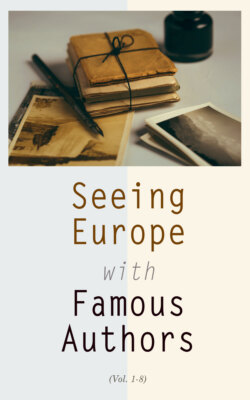Читать книгу Seeing Europe with Famous Authors (Vol. 1-8) - Гарриет Бичер-Стоу - Страница 27
EXETER1 By Anna Bowman Dodd
ОглавлениеA very obvious part of the charm of Exeter Cathedral lies in the fact that it has to be sought for. It is so well and dexterously concealed from view, as one passes along High Street, that one might be some days in town without so much as suspecting that one of the finest cathedrals in England was a near neighbor. It was almost by chance, I remember, that as we turned into a long, quaint alley-way, filled up with little, low shops, we caught a glimpse of a green plot of grass and some trees in the distance. Our guiding instinct divined these to be the cathedral close. …
To analyze the beauties of Exeter is only to add another note to one's joy in them, their quality and rarity being of such an order as to warrant one's cooler admiration. The front is as unique in design as it is architecturally beautiful. There is that rarest of features in English cathedrals—an elaborately sculptured screen, thoroughly honest in construction. In originality of conception this front is perhaps unrivalled, at least on English soil; there are three receding stories, so admirably proportioned as to produce a beautiful effect in perspective. The glory of the great west window is further enhanced by the graduated arcades which have the appearance of receding behind it. Above the west window rises a second and smaller triangular window in the gabled roof.
Thus the triangular motif is sustained throughout, from the three low doorways in the screen up to the far-distant roof. This complete and harmonious front is nobly enriched by the splendid note of contrast in the two transeptal Norman towers, whose massive structural elegance and elaborateness of detail lend an extraordinary breadth and solidity to the edifice.
The grandeur which distinguishes the exterior is only a fitting preparation for the solemnity and splendor of the interior. Passing beneath the thickly massed sculptures of the low portals, the effect of the vastness of the nave is striking in its immensity. Curiously enough, in this instance, this effect of immensity is not due to an unbroken stretch of nave-aisles or to a lengthy procession of pier-arches, but to the magnificent sweep of the unencumbered vaulting in the roof. An organ screen intercepts the line of vision at the entrance to the choir. This, however, is the sole obstruction which the eye encounters. Above, the great roof, with its unbroken 300 feet of interlacing lines, rises like some mighty forest, its airy loftiness giving to the entire interior a certain open-air atmosphere of breadth and vastness. …
What most deeply concerned us was the desire to secure an uninterrupted session of contemplative enjoyment. We had lost our hearts to the beauty of the cathedral, and cared little or nothing for a clever dissecting of its parts. We came again and again; and it was the glory of the cathedral as a whole—its expressive, noble character, its breadth and grandeur, the poetry of its dusky aisles, and the play of the rich shadows about its massive columns—that charmed and enchained us. It was one of the few English cathedrals, we said to each other, that possess the Old-World continental charm, the charm of perpetual entertainment, and whose beauty has just the right quality of richness and completeness to evoke an intense and personal sympathy; for in all the greatest triumphs of art there is something supremely human.
1 From "Cathedral Days." By arrangement with, and by permission of, the publishers, Little, Brown & Co. Copyright, 1887.
